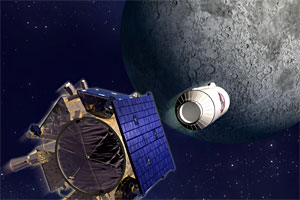When the LCROSS satellite, nicknamed Centaur, smacks into the south pole of the moon in late October, it is expected to produce a plume of dust 37 miles high, which may be visible from Earth with a good backyard telescope. It will be visible in an arc from Hawaii to Texas.
If you'd like to catch the impact, the Chabot Space and Science Center in Oakland is hosting a Shooting the Moon star party on the night of impact. Morrison Planetarium in San Francisco may host a star-gazing event, as well, but it hasn't been announced yet. And you could check in on other observatories in the Bay Area, as well: Lick observatory in the Santa Cruz mountains, Foothill observatory in Los Altos Hills, Sonoma State observatory in Rohnert Park, and the Fremont Peak observatory in the East Bay.
Not all of them will be open to the public; for instance, Foothill Observatory will be closed to the public, because they’ve been asked to take photographs of the event.
If you know anyone with a 10-inch telescope (that's the diameter of the lens), you can bet that telescope will be lined up to look skyward when the LCROSS probe hits the moon.

